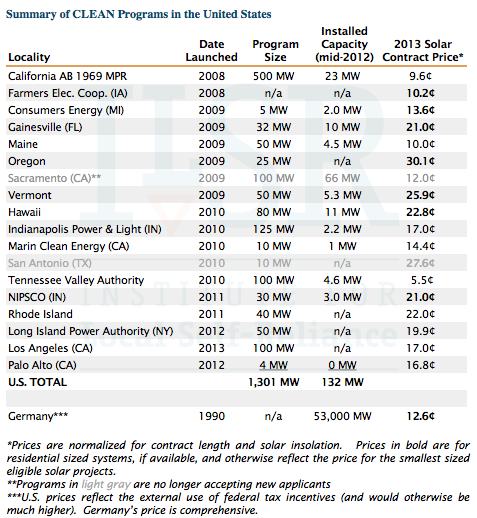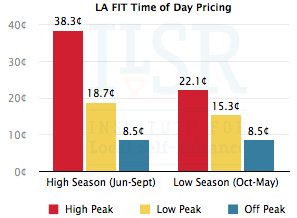Three Key Features Of Los Angeles’ New Local Solar Program
Officially launched in January after years of development, a new CLEAN (feed-in tariff) program from the Los Angeles Department of Water and Power (the city’s municipal electric utility) promises 100 MW of new local renewable energy by 2016. In absolute size, the program will be among the largest CLEAN programs in the US, but compared to the size of the population it serves, the new LA program ranks behind national leaders like Gainesville, FL, or Vermont (the city’s peak demand tops 6,000 MW). Even so, the Los Angeles program is a good example of a community increasing the capture of local energy dollars with local energy generation.
The official announcement of the Los Angeles program puts the total energy capacity for U.S. CLEAN programs over 1.3 gigawatts. The following table, updated from our 2012 report on CLEAN Programs, shows Los Angeles in the context of other state and local programs. Prices are normalized for the local solar resource and program contract length. Interestingly, the adjusted German price for residential PV (down 3 cents since the 2012 edition) is still better than most US programs, reflecting their ongoing cost advantage.
 Chip in a few dollars a month to help support independent cleantech coverage that helps to accelerate the cleantech revolution!
Chip in a few dollars a month to help support independent cleantech coverage that helps to accelerate the cleantech revolution!
The LA program supports renewable energy projects (most likely solar) with a 20-year, fixed price contract at 17¢ per kilowatt-hour (kWh). Projects must be between 30 kilowatts (kW) and 3,000 kW, and the program will roll out in five, 20 megawatt (MW) phases every six months over the next 3 years. A full 20% of capacity in each phase (4 MW) will be set aside for smaller projects, between 30 and 150 kW.
The program has three distinguishing features from other CLEAN programs:
- The price was set based on a pilot, competitively bid 10 MW program in 2012 that had an average accepted bid price of 17.5¢ per kWh
- The 17¢ per kWh fixed price contract is adjusted based on the time of day and season of production. The time of day adjustments are likely to increase the per kWh payment to approximately 18.1¢ per kWh (based on sample data provided by LADWP)
- The contract price will decrease automatically by 1¢ per kWh for each phase of the program, falling to 13¢ per kWh for the final 20 MW phase.
The time of day multiplier ranges from 2.25 for “high peak” demand on weekdays in the summer season to 0.5 for off peak energy (weekday evenings and weekends). The following chart shows the approximate per kWh payment for energy based on its time of production (for phase 1).
About a quarter of solar output falls into this high peak during the offseason, with approximately one-third of solar output coming during high peak in the summer. The end result is an average per kWh payment of 18.1¢ per kWh, about 6.5% higher than without the time of day multiplier.
The FIT program has three other good policy design features worth mentioning. The program limits participation to one project per property parcel, helping to widen the opportunity. Projects have 18 months to reach commercial operation (perhaps still a bit too long given the aggressive price declines in the industry), but lower than the 3 years in Ontario, for example, where premium contracts are awaiting fulfilment as profit-oriented developers wait to lock in ever-lower panel prices. The third is that while the queue for the program is “first come, first served,” projects that apply within the first 5 business days are treated as coincident, with a lottery selecting the winners from that pool. This helps community-based and smaller projects compete against large developers with the in-house resources to get the paperwork together.
The program may not make a huge dent in the city’s collective energy spend or its peak demand, but its design highlights the careful consideration of the policy and makes it a likely success.
Have a tip for CleanTechnica? Want to advertise? Want to suggest a guest for our CleanTech Talk podcast? Contact us here.
Latest CleanTechnica.TV Video

CleanTechnica uses affiliate links. See our policy here.



